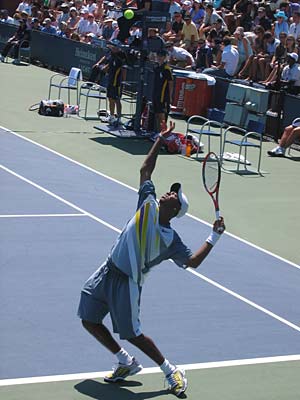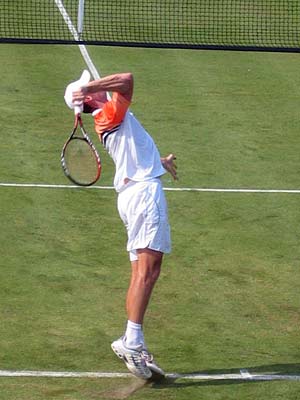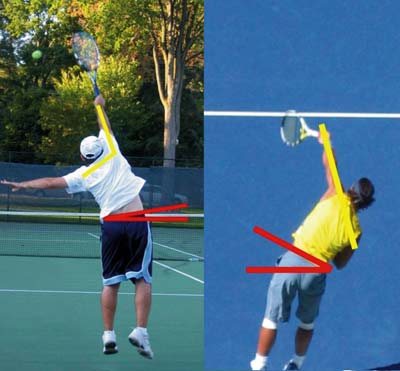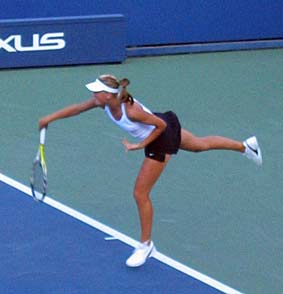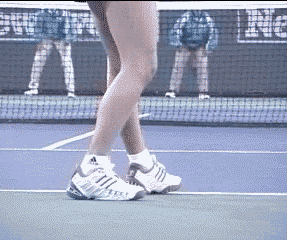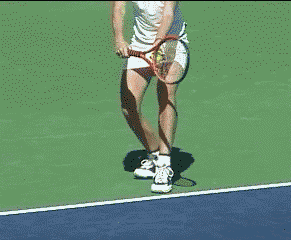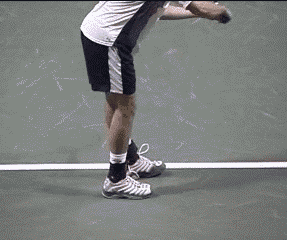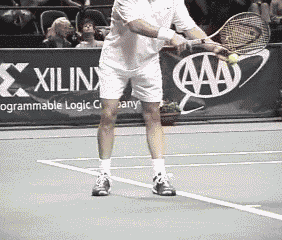|
TennisOne Lessons The Serve: Developing Leg Action Doug Eng EdD, PhD On the tour, the serve is a powerful weapon. It allows players such as John Isner, Ana Ivanovic, Ivo Karlovic and, Venus Williams to dominate their service games. But how do the pros develop such formidable serves? Or what differentiates a young person’s serve, a club player’s serve, and a touring pro’s motion? Top coaches and biomechanists point out several key differences between these levels of players. In this article, we will focus primarily on the leg differences.
Biomechanics of the Lower Body Although the major source of power on the serve comes from internal shoulder rotation, the base is the legs. The legs may not be the major source of power but think of them as the ignition key. Many younger players copy Andy Roddick’s abbreviated backswing, but they can’t get significant power until they physically mature. Nick Saviano, the former Director of USTA’s Player Development who now runs his own world-class academy in Florida, suggests that younger players have difficulty stabilizing their base, the legs. Failure to stabilized the feet undermines the kinetic chain. This chain is how power translates through the body. The first segment is the interaction of the legs and ground. Movement goes through the hips and core, then through the shoulders, and lastly, through the elbow, wrist, and hand. Also, many club players mistime the knee bend which is critical to using the legs properly. That is, many juniors and club players will bend the knee before the toss or sway on the toss. Touring pros will toss and then sink the knees as Jim McLennan suggests (The Service Motion - Ground Reaction Forces). The pro then achieves what is known as the power position. In the photo on the right, we see Donald Young show a terrific power position which is important for his recent serving successes. The body forms an L-shape with the bend primarily at the knees. The racquet has not fallen back yet as many club players allow it to do. Young uses a platform stance with the feet separate. Pros often call this stance the foot back position to differentiate between foot forward, feet together, or the pinpoint stance. In either case, the knees flex after the toss.
Often, a growing adolescent is gangly and a bit awkward with his or her body. That affects coordination, balance, and stability. Watch a few decent juniors at your tennis facility and pay attention in particular to their feet when they are serving. They will often move the feet more frequently than an adult. Saviano often looks at the front or left foot (for a right-handed player) as the base stabilizer. In the photos on the right, we see a comparison of a young player (left) and Rafael Nadal (right). Often the left or front foot will move around and destabilize the young player’s balance and power. It is also common for the player to slide the back foot too far forward. In the photo, although the junior did not move the base foot, the right foot moved forward (red line). The player is attempting to move the foot up or into the pinpoint position that Nadal has achieved (in contrast to Donald Young’s platform stance above).
Another common error we see (yellow line) is the racquet face position, which opens up too much. That will not only reduce spin, it will also limit the distance the racquet can drop behind the back in what is known as the launch position. Sometimes, teaching pros attribute the excessive foot movement to the ball toss, but more frequently it is the awkwardness of the growing adolescent and also the relatively lack of core strength. Core strength is paramount to developing the serve. Bruce Elliott, a top biomechanist from Australia, points out that core strength allows what he calls the “hip over hip” motion on the serve. This is the cartwheel action or reaching up and over like on a hook shot in basketball. A young player is often less coordinated on this component due to lack of strength. Therefore, even if the youngster can hit the ball fairly hard, it is not struck as heavy as an adult’s serve. And that is why, a good teaching pro won’t have a junior, under 12 years of age, develop a kick serve. In the photo comparing Nadal and a junior player, the red line shows the foot sliding forward. That also limits the “hip over hip” action Elliott endorses. Sliding the back foot forward even along the baseline opens the hips and does not promote a hip tilt. The photo below again compares the club junior and Nadal. The two red lines denote the hip tilt angle which is only a few degrees in the junior’s case (left). Nadal (right) rotates and tilts his hip at a 25-30 degree angle as shown by the red lines.
A second major error (yellow lines) club players tend to make is to severely reduce the angle between the racquet arm and the shoulder. This can promote shoulder injuries. Note Nadal’s shoulder and arm are aligned (yellow line). Finally, what happens with the feet after contact? Of course, many players leave the ground due to the upwards and rotational forces generated by the serve. The photo below shows Victoria Azarenka from Belarus, who defeated Martina Hingis in the third round of the 2007 US Open. Azarenka gets about a foot into the court with the front foot. In addition, her back foot kicks almost straight back which balances her arm extension with the racquet. She is probably hitting a flat first serve here. If she applies more spin, her back leg might go less back but more to the side as her racquet arm will also not go as far forward. In effect, think of a balancing act or a reactionary force to counteract the forward movement of the racquet.
Let’s keep these points in mind. To summarize:
Video-Analysis Now let's examine a few serves from our TennisOne ProStrokes Gallery. I chose the videos showing only the legwork which makes it easier to focus on salient points. Elena Dementieva Elena Dementieva is known for a relatively poor serve among touring pros. Let’s watch her video.
She uses a fairly narrow platform stance here. When she bends her knee, she doesn’t quite achieve the "L" power position. So she can’t drive from her hips as well as Nadal or Young in the previous photos. Her front foot lands only maybe three inches into the court although her right leg kicks back fairly well. Martina Hingis Martina Hingis is also not known for a great serve. Note how she gets a small rocking motion to the back foot (below left) which is good to assist the power position. She uses a pinpoint stance bringing the back foot up. However, her right foot slides even with the left which reduces her hip over hip action. She won’t hit a heavy serve, much less with her small size. She does have a reasonably good step in and back kick, however.
Justine Henin We see Justine Henin’s serve next (above right). This video shows a younger Justine when she had less power and a pinpoint stance. She shows a good pinpoint stance where the right foot slides behind the left foot rather than even. She could get a bit straighter in the back (use a slight arch) but we can see how she drives off both feet together. Justine gets over a foot into the court and has a nice back kick. Finally, it is hard to see, but check out her hip over hip action. She gets about a 20 degree hip tilt which is good. Andy Roddick Andy Roddick (below left) uses a narrow platform stance and gets a terrific knee bend. He does not get much hip over hip action here which means he is probably hitting relatively flat. Also check out his follow-through (look for the racquet face) which shows not much pronation. Therefore, he might have been hitting a big flat (or slightly slice serve). He does get fairly high and into the court (maybe 1.5 feet) so he generated a large amount of force.
Andre Agassi Finally, Andre Agassi (above right) shows a classic platform stance where he gets significantly off the ground. He uses a deep knee bend (as deep as Roddick) but gets off the ground much more perhaps as he is using a kick serve. Andre gets about 1.5 feet into the court with a nice back kick. Conclusion By isolating a segment of the kinetic chain – the legs in this case – we are able to focus on detailed learning. It is important to note, however, that though the legs are important as a triggering element, they are really only one part of the service motion. One can have really great leg action but still have a rather ordinary serve due to a breakdown in the mechanics above the waist. In addition, some players with mediocre leg drives can hit very effective serves due to their superior arm and upper body mechanics. Best of luck with your serve! Your comments are welcome. Let us know what you think about Doug Eng's article by emailing us here at TennisOne.
Doug Eng EdD PhD coaches men's tennis at Tufts University. During the summer, he directs at the Tennis Camps at Harvard. He has received divisional Pro of the Year honors from the PTR and USPTA and several national award. Doug completed the USTA High Performance Coaches program and frequently runs educational and training programs for coaches. Doug also writes and speaks on tennis and sport science. |

